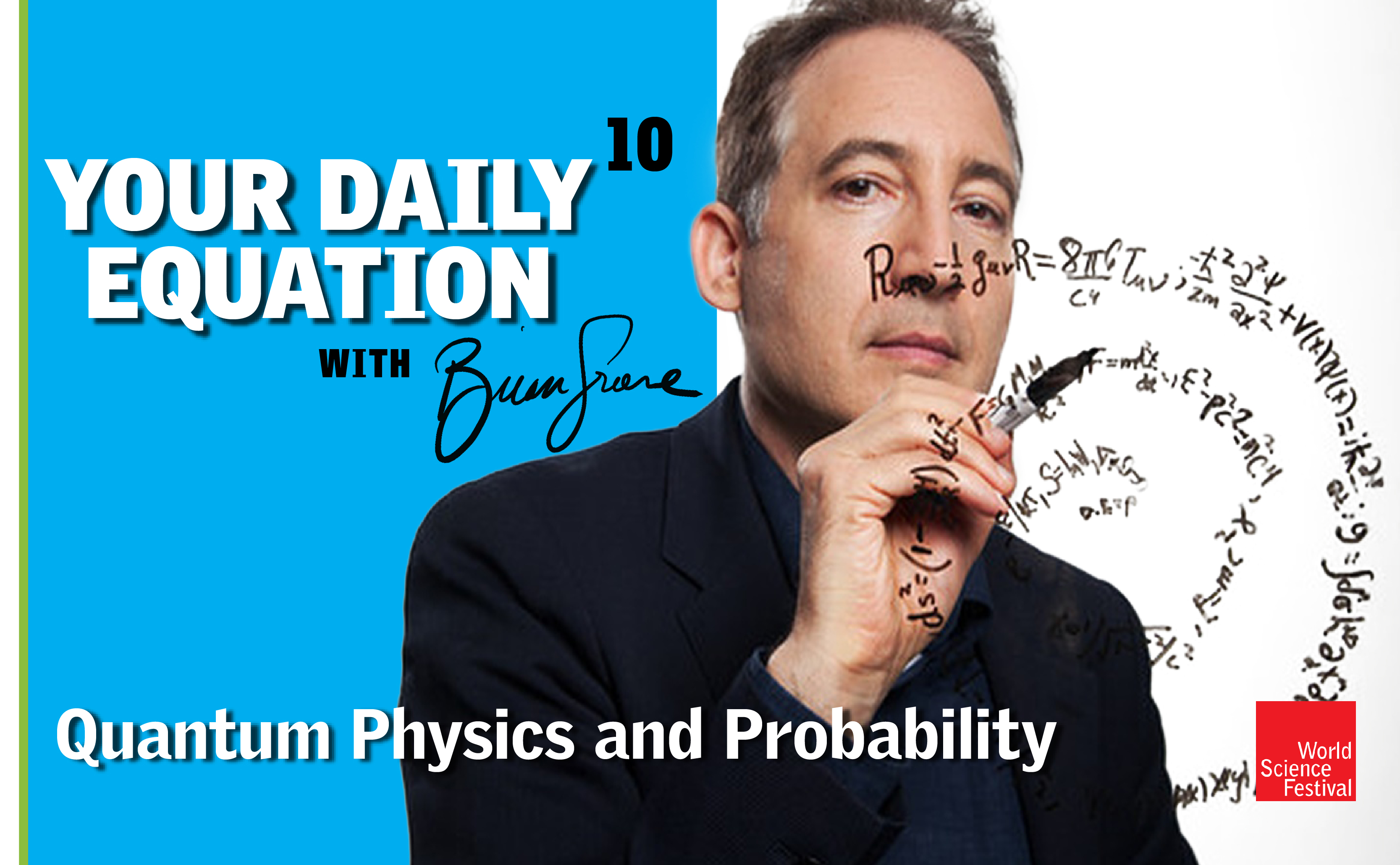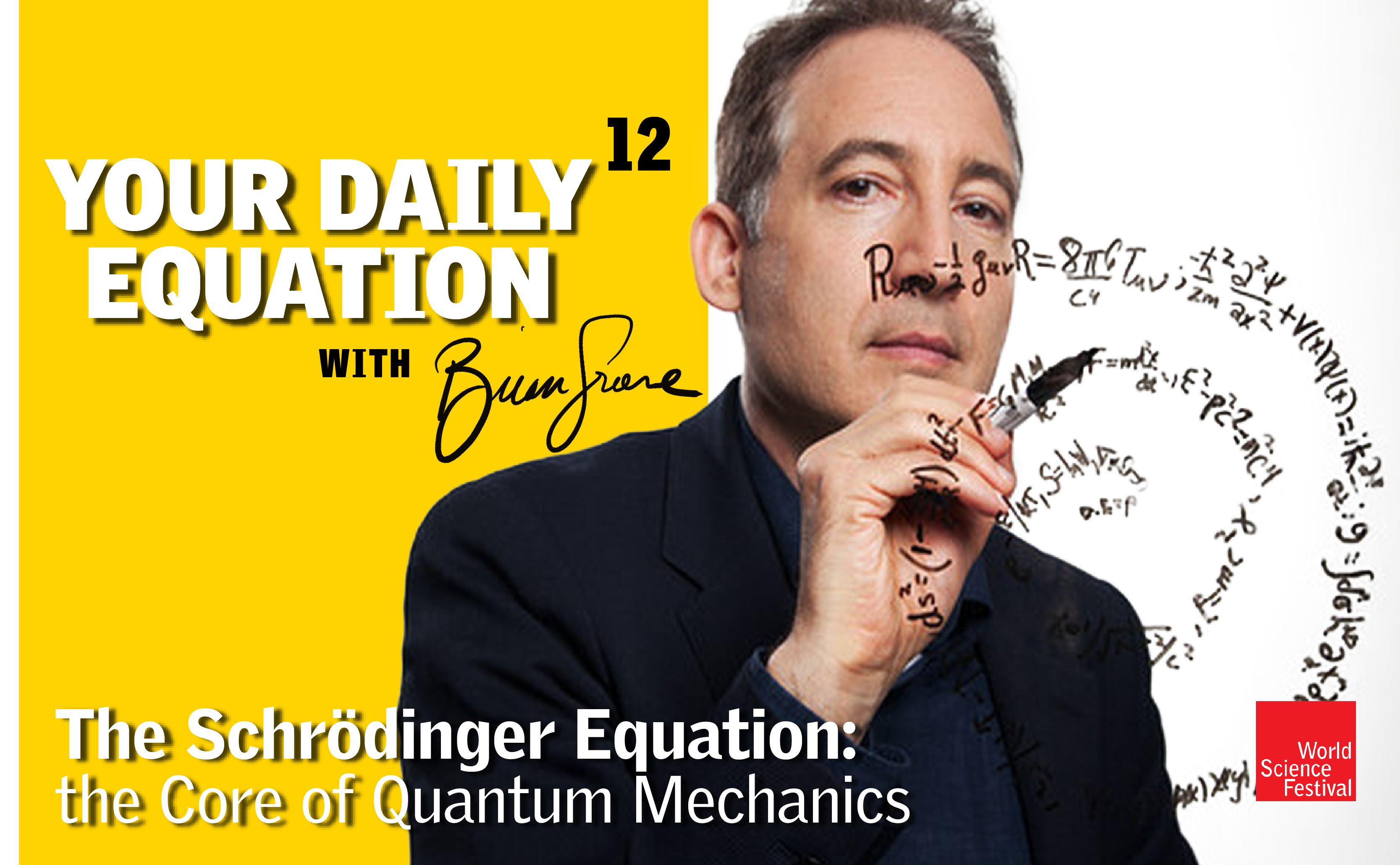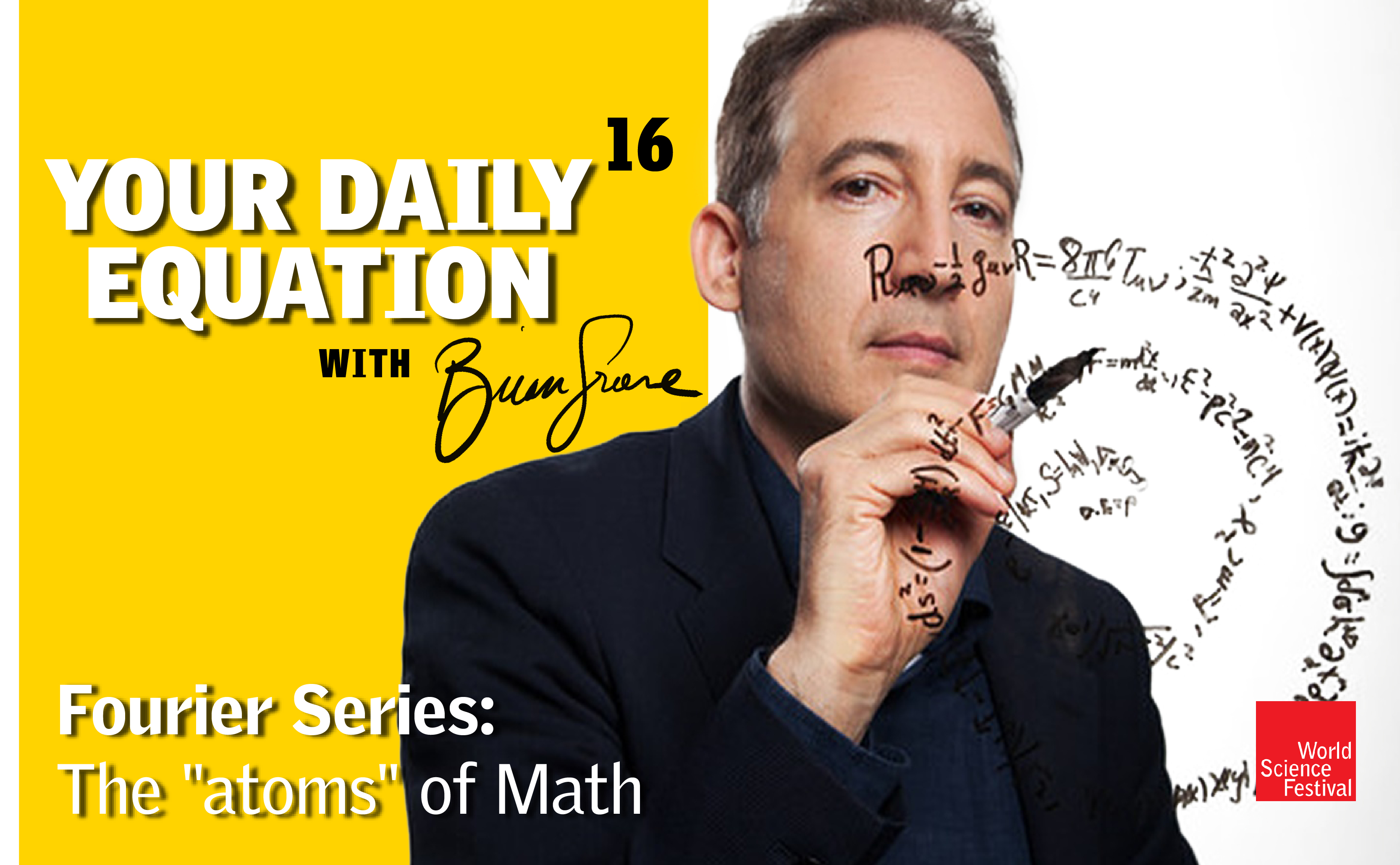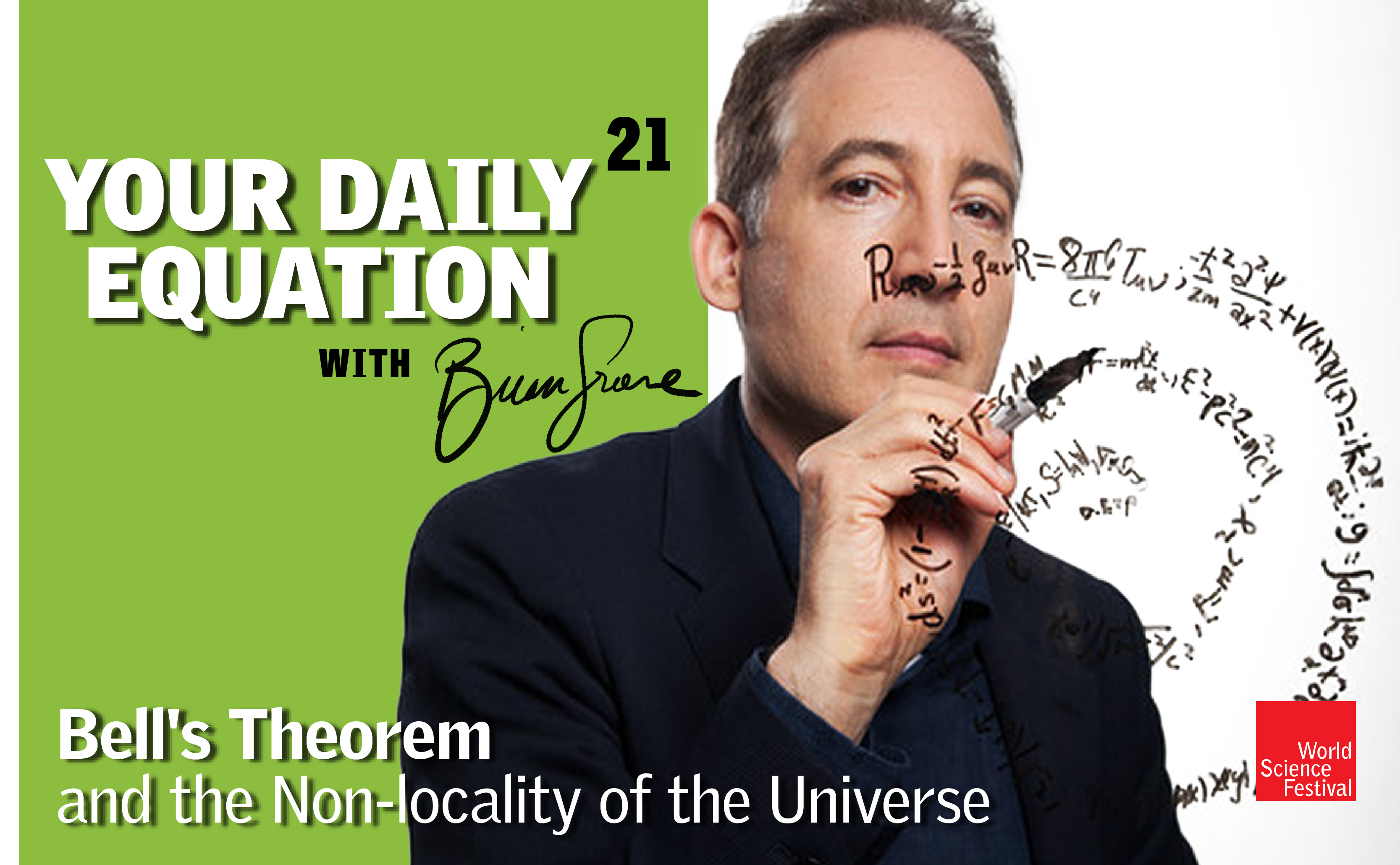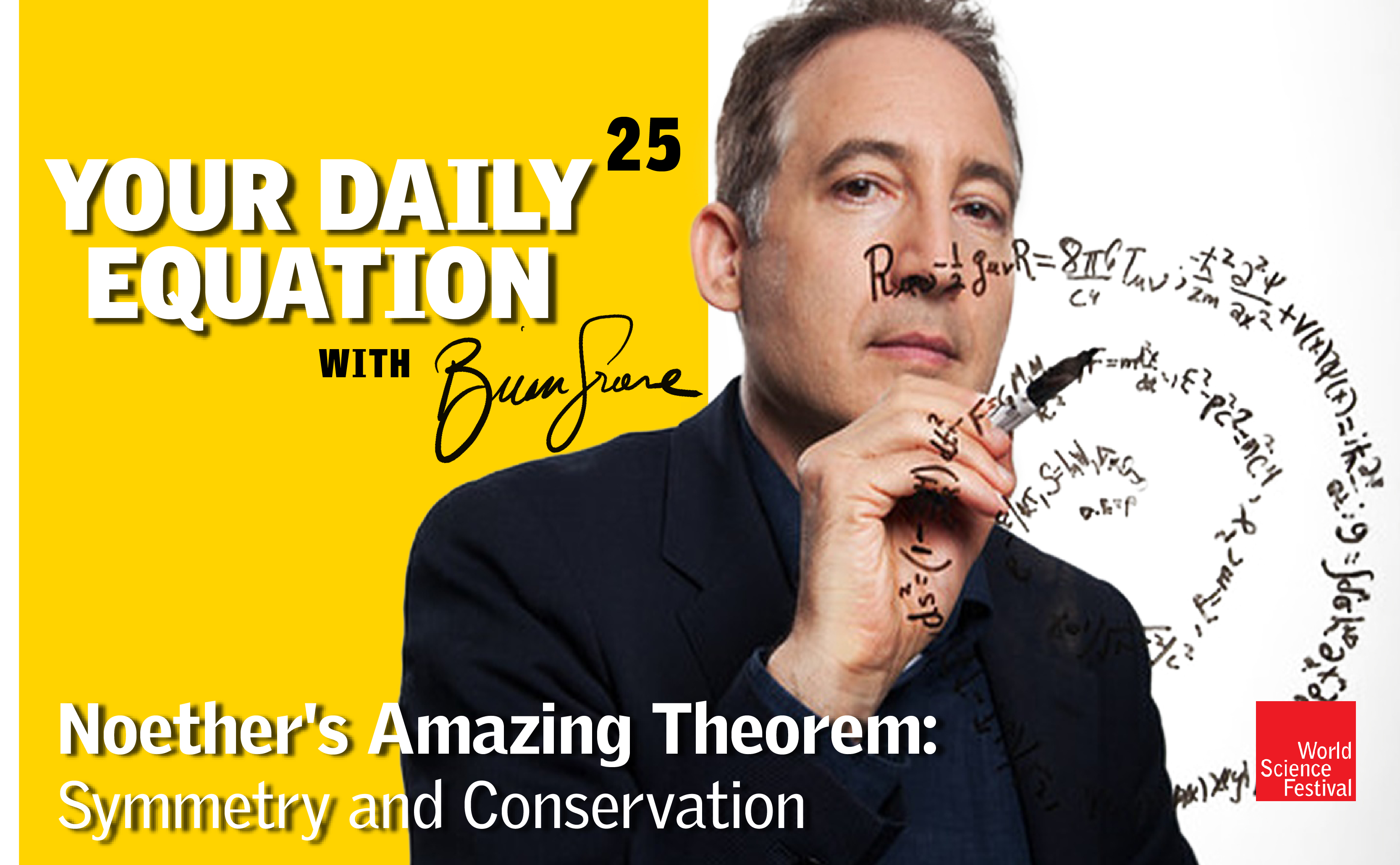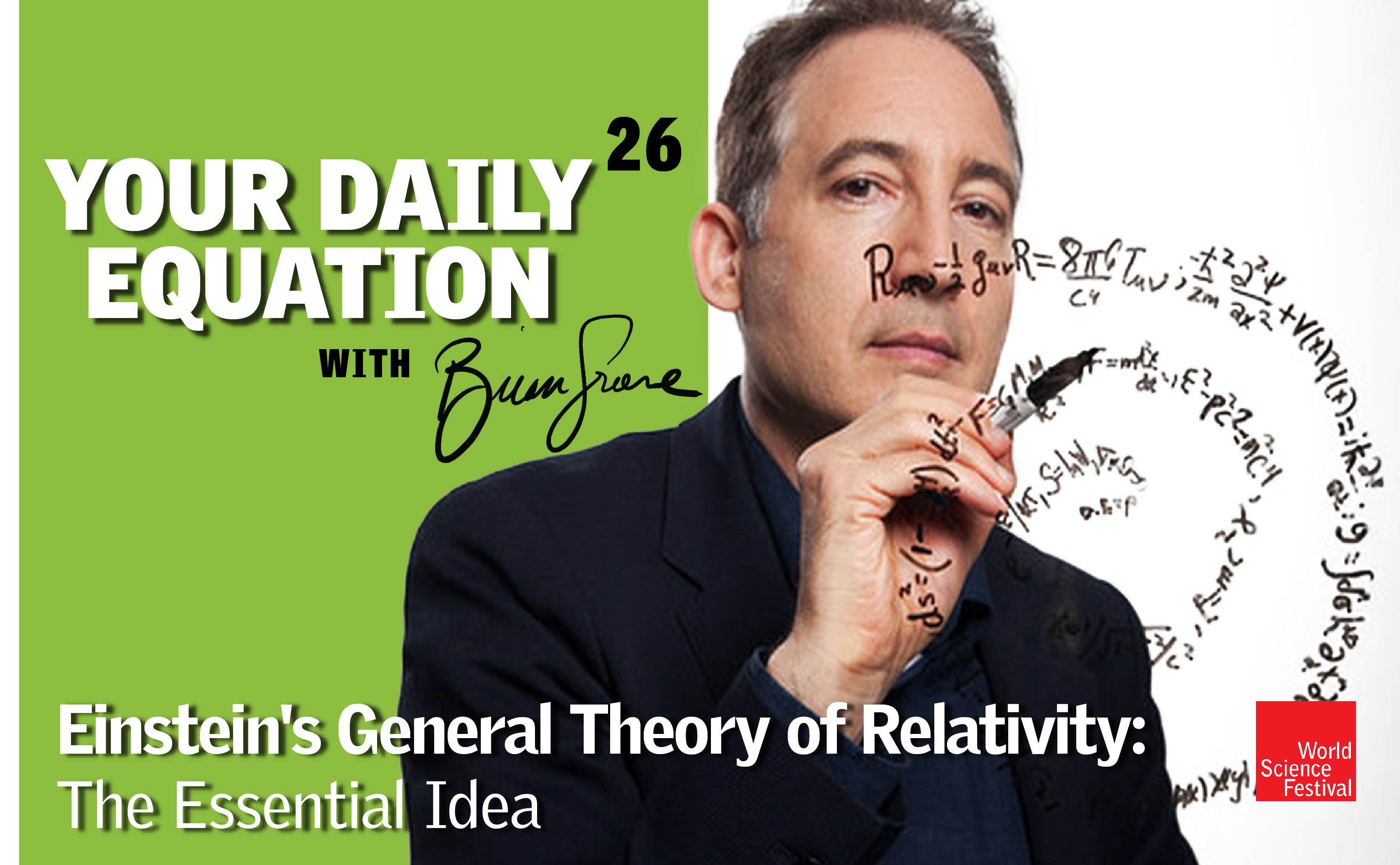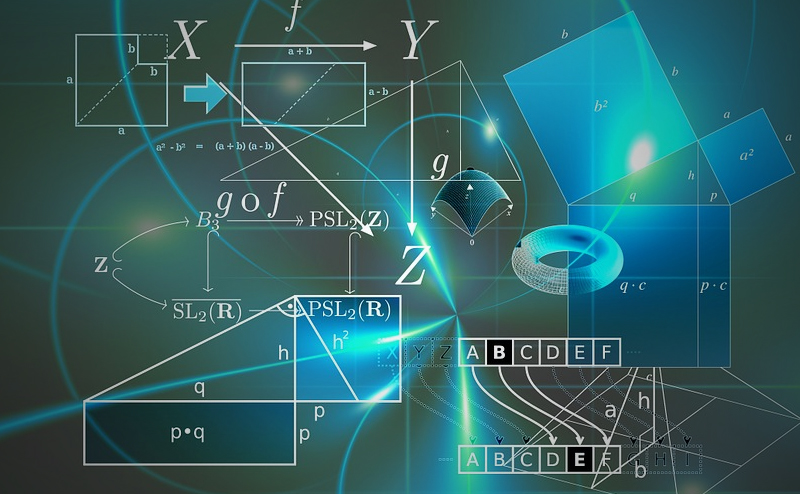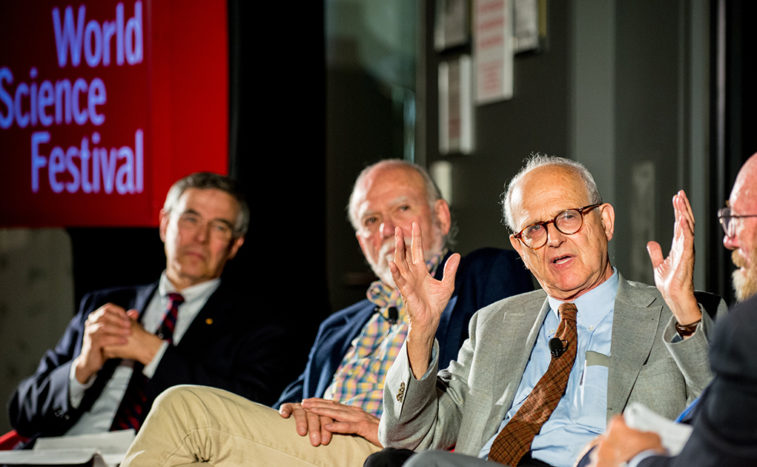8,000 views | 01:41:16
Join us for #YourDailyEquation with Brian Greene. Every Mon - Fri at 3pm EDT, Brian Greene will offer brief and breezy discussions of pivotal equations. Even if your math is a bit rusty, tune in for accessible and exciting stories of nature and numbers that will allow you to see the universe in a new way. Episode 31 #YourDailyEquation: Shortly after Einstein wrote down his new equations for gravity--his general theory of relativity--a German mathematician found the first exact solution. And within that solution physicists realized that a strange new entity was lurking: black holes. Join Brian Greene for a visual exploration of black holes and some of the mathematics that underlies them.Learn More
Speaker 1:
Hey, everyone. Welcome to this next episode of Your Daily Equation, or maybe it’s going to be your every other day daily equation, your semi-daily equation, whatever it is, you’re bi-daily equation. I never know what the right usage of those words actually is. But in any event, I’m going to focus today on the question, the issue, the subject of black holes. Black holes. Black holes are an amazingly rich arena for theorists to try out ideas, to explore our understanding of the force of gravity, to explore its interaction with quantum mechanics. As will I mention, black holes are now also an arena, which is rich and fertile for observational astronomy. We’ve gone beyond the era in which black holes were merely theoretical ideas to now the recognition that black holes are real, they are really out there.
I’ll also note at the end that there are great many puzzles to do with black holes that have yet to be resolved, and maybe if I have time, I’ll mention a few of those, but I’d like, for the most part, to focus here, in this episode, on the traditional, more straightforward, widely, well, not completely, but more widely accepted historical version of the trajectory that led us to recognize the possibility of black holes and some of the properties that emerged from the basic mathematics of Einstein’s equations. To get us going, let me just give a little bit of historical background. The story of black holes begins with this fella right here, Karl Schwarzschild. He was a German meteorologist mathematician. Really smart guy, astronomer, who was actually stationed on the Russian front during World War I.
As he’s there and he’s charged with actually calculating trajectories of bombs, you just hear them going off and so on. Somehow, in the trenches, he gets hold of Einstein’s paper on the general theory of relativity. Does some calculations on it and realizes that if you have a spherical mass and you crush it to a very small size, the bombs are still going off all around him. it will create such a warp in the fabric of space that anything that gets too close will not be able to pull away. That’s really what we mean by a black hole. It is a region of space in which enough matter has been crushed to a sufficiently small size that the warpage is so significant that anything that gets too close, closer than, as we will see, what is known as the event horizon of the black hole, cannot escape, cannot run away.
A sort of image that you can have in mind is, if have a little animation here of the moon going around the earth, this is the usual story of warped environment around the vicinity of a spherical body like the earth. But if you crushed the earth down to a sufficiently small size, the idea is that the indentation will be far greater than what we saw for the earth. The indentation would be so significant, that at least metaphorically speaking, if you’re hanging out near the edge of a black hole and you were to turn on a flashlight, if you’re within the event horizon, the light from that flashlight would not go off into deep space, instead it would go into the black hole itself.
This image is a little bit off, I should say, but it gives you at least a mental toehold for the idea of why is that light can’t get away from a black hole when you turn on a flashlight, if you’re within the event horizon of a black hole, the light shines inward, not outward. Now, another way of thinking about this idea, and look, I know this is quite familiar territory, black holes are in the culture. The phrase, falling into a black hole, or he did something and it created a black hole. We use that kind of language all the time. All of these ideas are familiar, but it’s good to have mental imagery to go along with the words. The mental imagery that I’m about to give you, I find particularly interesting and useful, because there’s a mathematical version of the story that I’m going to show you visually right now.
I’m not going to describe that mathematical story right now, but just know that there is a version of the so-called waterfall analogy that really can be fully articulated in a mathematical way that makes it rigorous. Here’s the idea. If you are near a waterfall and you are, say paddling your kayak, is that the right word? Yeah, paddling your kayak. If you can paddle faster than the rate at which the water is flowing toward the waterfall, you can get away. But if you can’t paddle faster than the water is flowing, then you can’t get away and you’re doomed to fall down the waterfall. Here’s the idea. The analogy is, space itself falls over the edge of a black hole, sort of like a waterfall of space, and the speed at which space travels over the edge of a black hole is equal to the speed of light. Nothing could go faster than the speed of light.
Near a black hole, you’re doomed. You might as well just paddle right toward the black hole and go on a joy ride down the throat of the black hole itself. That’s another way of thinking about it. Edge of a black hole event horizon, space, in some sense is flowing over the edge. It’s flowing over the edge at a speed equal to the speed of light. Since nothing can go faster than the speed of light, you can’t paddle upstream. If you can’t paddle upstream, you can’t get away from the black hole, you’re doomed and you will fall into the black hole. Now, that all is highly schematic and metaphorical is useful for thinking about black holes.
But for a long time, we knew what black holes should look like if we were to ever see them. We wouldn’t literally see the black hole itself, but in the environment around a black hole, as material is falling over the event horizon of a black hole, it heats up. The material rubs against the other material that’s all falling inward. It gets so hot that the frictional forces heat up the material and they generate x-rays. Those x-rays go out into space. Those x-rays are things that we can see. Let me now just show you, therefore, the expected view of a black hole would be something like this. Around the edge of the black hole, you see the swirling maelstrom of material giving off these high energy x-rays.
I’ve put them in the visible so we can see them. Within that maelstrom of activity is a central region from which no light itself is being released, no light is being emitted, and that would be the black hole itself. Now, Schwarzschild was doing his work, as I said, it was World War I. We’re back in 1917 or so. He puts forward this idea of this solution. I’ll show you the mathematical form of that solution as we go forward. But there’s a real curious feature of … well, there are many curious features of the solution, but one in particular is, for an object to become a black hole, you got to squeeze it down, but how far do you have to squeeze it down?
Well, the calculation show that you’d have to squeeze the sun down to about three kilometers across or so to be a black hole, the earth you’d have to squeeze it down to a radius of about centimeter or so to be a black hole. Think about the earth down to a centimeter. It doesn’t seem like there’d be any physical process that would ever allow material to be compressed to that degree. The question is, are these objects just mathematical implications of the general theory of relativity, or are they real? A step in the direction of showing that they’re real was taken some decades later when scientists realized that there is a process that could actually lead to matter collapsing in, on itself, and thereby crushing it down to the small sizes required for the black hole solution to be realized physically. What are those processes?
Well, here is the canonical. One, imagine we’re looking at a large star, like a red giant. That star supports its own hefty mass through nuclear processes in the core, but those nuclear processes, which give off the heat, the light, the pressure, ultimately they will use up the nuclear fuel, and when the fuel is used up, the star will now begin to implode in, on itself, getting hotter and denser toward the core until ultimately, it will heat up to such a degree, then an explosion will take place. That explosion will ripple through layer upon layer of the star until the explosion ripples right to the surface, blows off the surface of the star, a supernova explosion, and what remains is a core that doesn’t have any nuclear reaction to support it.
That core will collapse all the way down into a black hole. A black hole in space taking the form that I showed you a moment ago, a region from which no light is escaping. In this image here, you see the black hole’s gravity is bending the starlight around it, creating this interesting lensing effect, but that’s at least a process in principle that could lead to the formation of a black hole. Now, what about actual observational data that supports these ideas? All of this is highly theoretical at the moment. Look, there has been data accumulated for a long-time, observation of the center of our Milky Way. Galaxy show that stars whipping around the center, so it’s fantastically high velocities, and the entity responsible for creating the gravitational pull that was whipping in them around was so incredibly tiny, that for a tiny region to give rise to the gravity necessary to explain the whipping motion of the orbiting stars, scientists concluded that the only thing capable of doing that would be a black hole.
That was interesting indirect evidence for the existence of black holes. Perhaps the most convincing evidence from a few years ago was the detection of gravitational waves. You may recall that if you have two orbiting objects, and I’ll do this at some point in some episode, as they orbit, they ripple the fabric of space. As they ripple the fabric of space, they send out these wave train of distortions in the space-time fabric that in principle we can detect. In fact, we did detect it first time back in 2015. When the scientists did the analysis as to what was responsible for the squeezing and the stretching, not of this degree as we see in this animation of planet earth, but a fraction an atomic diameter, the arms of the LIGO detector stretched and contracted in schematic manner shown by this earth that’s being distorted.
When they worked out the source of the gravitational waves, the answer came out to be two black holes that were orbiting each other rapidly and collided. That was nice evidence in support of black holes. But of course the most convincing evidence of all is to see a black hole. Indeed, that’s what, in some sense, the event horizon telescope did. A consortium of radio telescopes around the world were able to focus on the center of a distant galaxy, M87, I believe, and they combined data that they were able to amass from those observations, gave rise to these famous “photograph.” It’s not actually a camera, it’s radio telescopes, but this famous photograph where you see the telltale ingredients.
You see the glowing gas around a dark region, black hole. Wow, amazing. Imagine that chain of events. Einstein writes down the general theory of relativity 1915, it’s published in 1916. Some months later, Schwarzschild gets ahold of the manuscript, works out the solution to the equations for a spherical body. He beats Einstein to the punch. I probably should have emphasized that early on. Einstein wrote down Einstein’s equations, of course, but he was not the first person to solve those equations, to solve them exactly. Einstein wrote down approximate solutions that are really good in situations that are not too extreme, like the bending of starlight near the sun, the motion of mercury, it’s orbit.
These are situations in which the gravity is not strong, so an approximate solution to his equations is all they actually need to work out the trajectory of starlight, or the trajectory of mercury, but Schwarzschild writes down the first exact solution to Einstein’s equations of the general theory of relativity, wonderful achievement. Embedded in that solution to those equations is the possibility of black holes. Then, in, whatever it is, 2017, when was … 2018? When was the event horizon? Time goes so fast. Whenever it was, 2018, ’19, I don’t know. Somewhere in there. Roughly speaking, 100 years later, we actually have the closest you can imagine to a photograph of a black hole. That’s a beautiful scientific story, a beautiful scientific achievement.
What I want to do now in the remaining time is just quickly show you some of the math behind all of this. Let me actually switch over to my iPad here. Why is it not coming up? Please, don’t mess me up here. Yes, I think we’re good. Let me just write and see if it’s coming up. Yes. Good. All right. We are talking about black holes. Let me just write down some of the essential equations, and then, I want to at least show you in the math, how you can get to some of the iconic features of black holes that you may know a lot about, or at least you may have heard of. If you haven’t, they’re mind boggling in their own right. What’s the starting point?
The starting point, as always, in this subject is Einstein’s equations for gravity and the general theory of relativity. You’ve seen these before, but let me write it down. R mu\nu minus a half, G mu/nu R equals eight PI, Newton’s constant G, speed of light fourth, times the energy momentum tensor T mu/nu. This first guy over here, this is a so-called Ricci tensor, scalar curvature, energy momentum tensor metric on space-time. Again, remember, we are describing curvature in terms of a distortion to the distance relationships between points in a space. A good example, if I can just switch back over half a second here, I showed you this earlier, but here’s the Mona Lisa painted on a flat canvas.
But if we curve the canvas, if we warp it, if we distort it, look what happens. The distance relationships between points on her face, for example, are being changed. Curvature is reflected in this way of thinking about things as a distortion in those distance relationships. The metric, let me go back. Good. The metric over here is what allows us to measure distance relationships. It defines the distance relationships on a geometrical space, and that’s why it comes into the story. What we want to do now is to take these equations and try to solve them in a certain circumstance. What’s that circumstance. Imagine you have some central mass M.
Imagine that say the origin of the coordinate system, and imagine that it’s spherical and that everything else is spherically symmetric, and that gives us a simplification on the metric because a general metric will have distance relationships that can vary in a non-symmetric manner. But if we’re looking at a physical circumstance in which we have a sparkly symmetric mass, then the metric will inherit that symmetry … It will be spherical symmetric, and that allows us to simplify the analysis because the metric now has a particularly special form. Our goal then is to do the following. Outside of this mass, and let me just use a different color here, and say any of the regions …. come on, please. Any of these regions out here, outside of the mass itself, there is no energy momentum at all.
That would be T mu/nu equals zero. The only place in which the mass is going to come into the story is when we solve the differential equations, the boundary conditions at infinity will need to reflect the fact that the space does have a body within it. But the equations that we are going to solve are the equations that are relevant as external to that body. Outside of that body, there is no additional mass or energy. We’re not going to imagine of any swirling gas or any of the things that I showed you in the animation. I’m going to keep it really simple. We’re going to solve the Einstein field equations and the static spherically symmetric circumstance in which the energy momentum tensor outside of the central mass is equal to zero advantages.
Okay, so now let’s do that. Now, I’m not going to actually take you through the detailed analysis of finding the solution, not particularly illuminating it. I think you’d find it a little bit boring or me to write down all the terms, but what I will do is I just want to give you a feel for how complicated the Einstein field equations in general are. Now, what I’m going to do is very quickly just write down those equations in a more specific form. Here we go. I’m going to write down here, the Riemann tensor answer quite quickly, Riemann tensor answer in terms of the Christoffel connection that gives us parallel transport.
I’ll then write down the Ricci tensor and the scalar curvature, which has come from tracking the Riemann tensor along various indices. I’ll then write down the connection in terms of the metric and its derivatives. This is the metric compatible connection that ensures that under parallel translation, the length of vectors do not change. Therefore, we have the chain of events that we start with a metric that gives us the connection in terms of that metric, that gives us the curvature, Riemann curvature in terms of the connection, in terms of that metric, and then we can track them in the various ways as I’ve shown you. That gives us the left-hand side of Einstein’s equations, the complicated nonlinear differential function of the metrics.
We have a differential equation that we need to solve. What happened is, now get to what Schwarzschild did, he took that complicated mess that I just rapidly showed you, and he found an exact solution to the equations. Let me write down the solution that he found. As his conventional, I will write down the metric as G equals G alpha beta DX alpha, DX beta. Repeated indices are summed over. I don’t always say that. I don’t always write it, but just recognize we’re using the Einstein summation convention. Alpha and beta are repeated, which means they run from one to four.
Sometimes people say zero to three, they’re running over T, X, Y, and Z, whatever numbers you care to assign to those particular variables. That is a metric. What I need to write down now is the particular coefficients G alpha beta that Schwarzschild was able to find in solving those equations in the circumstance that we were just looking at. Here is the solution that he finds in the trenches when he should have been calculating artillery trajectories during World War I. He finds that the metric G is equal to, lets write it in this form, one minus 2GM over C squared R, well, times C squared. I should write down here if I’m going to keep the season. I should at least be consistent. C squared, DT squared minus, where should I write that? I’ll write it over here. Minus, one minus 2GM over C squared R to the minus one, times DR squared, plus the angular part of the metric, which I’ll just write down as R squared D Omega.
I’m not going to talk about the angular part at all. I’m just really interested in the radial part and the temporal part, the angular part is symmetric, so there’s nothing particularly interesting happening there. There it is. There is the solution that Schwarzschild writes down. Now, when you look at the solution, there are a number of interesting things. Let me just give myself a little bit of space. I wrote too big, but I’ll try to squeeze it in over here. First of all, you might say to yourself, the situation of having a massive object, M, let me not do it there. The situation of having a massive object, well, far away from that massive object, it should look like Newton, you would think, right?
Does it look like Newton? Is there any hint of Isaac Newton in the solution that Schwarzschild found to these complicated nonlinear, partial differential equations from Einstein’s field equations? Indeed, there is. Let me set C equal to one, make it easier for us to recognize what we’re driving at. Just use the units where C is equal to one, one light per year, whatever units you want to use. Then you will note that this term over here, has within it, the combination GM over R. GM over R. Ring a bell? Right. That’s the Newtonian gravitational potential for a mass M, say sitting at the origin of the coordinates.
You see there is a remnant of Newton in that equation. In fact, truth be told, the way you solve this equation is by making contact with Newtonian gravity far away from the origin. The solution itself builds it in from the get-go is part of the way we find the solution, but be that as it may is beautiful to see that you can extract the Newtonian gravitational potential from the Schwarzschild solution of the Einstein field equations. That’s point number one, which is nice. Point number two that I want to make is that there are some special values of … Well, let me just … it’s not like I’m lecturing in front of a class, but let me just write this down.
Point number one, we see Newtonian gravitational potential in the solution. That’s cool. Point number two is that there are some special values of R. What do I mean by that? When you look at this solution, you notice, in particular, that if R equals zero, then some funny stuff happens, because you’re dividing by zero in those coefficients of the metric. What does that mean? Well, it turns out that that’s a big deal. That’s the singularity, the black hole singularity you see right there, the infinity that crops up as our ghost to zero in the coefficient of the metric. But now you might say, well, wait, what about also the value of R equals to GM or 2GM over C squared? But C is equal to one of these units. That’s a value for which this term goes to zero.
If it goes to zero, then this term is going to infinity. Another version of infinity cropping up, is that a singularity? And people thought that that was a singularity. R equal to zero is right here, but R equal to what’s known as RS, the short style value, and let me call this RS, 2GM over R. People thought, of course, it’s a whole sphere that I’m only drawing part of it. Early days, people thought that might be a singularity, but it turns out it’s not actually a singularity. It’s what’s known as a coordinate breakdown, or some people say coordinate singularity. It’s where the coordinates don’t work well. You’re familiar with this from polar coordinates.
Polar coordinates, when using R and theta, R theta, well, that’s a perfectly good way of talking about a point such as that, away from the origin, but if you’re actually at the origin and I say to you, okay, R is equal to zero, but what’s theta. Theta could be 0.2, 0.6, Phi, it doesn’t matter. Every angle at the origin is the same point. The coordinates are not good at that location. Similarly, the coordinates RT, and then the angular part theta and Phi are not good all along R equals RS. People have understood this now for a while, but are equal to RS, even though it’s not a singularity, is a special location, because look at it.
When you are, say heading in from infinity and you get to R equal to RS, and then say you cross over R equal to RS, look what happens here. This term, and this term, they changed their signs. When R is bigger than RS, then this quantity over here is smaller than one, and therefore one minus it is a positive number, but when our is smaller than RS, this term is now bigger than one, therefore one minus it is negative. Therefore, this picks up a negative sign as does this. Now, the only difference between a T and an R, as far as this metric is concerned, is the sign. If the signs flip, then in some sense, space and time flip. Wow. Space and time flip.
As you go across the edge, what you thought was time become space and what you thought was space becomes time again, because the only difference between space and time, as far as the metric is concerned, is this minus sign over here. Oh, and I wrote down things, funny here. That was confusing. This should be a minus sign also if I’m putting the minus in front of my space. Sorry about that, so go all the way back and imagine that. But the point is, again, focusing just upon the radial and the temporal part, the only thing that distinguishes the radio from the temporal as far as the metric is concerned is a sign, a plus or a minus.
When you cross over, R equal to RS, the plus and the minus interchange, space and time interchange. That actually gives us one way of thinking about why you can’t escape from a black hole. When you cross over R equal to RS, the spatial direction is now better thought of as a time direction. Just as you are unable to go back in time, once you cross over the event horizon, you can’t go back in the R direction, because the irregular direction is like a time direction. Just as you are ineluctably driven forward in time, second, after second, after second, once you cross over the edge of a black hole, you are ineluctably driven to smaller and smaller values of R, because it is, if you are being pulled forward in time. That’s another way of understanding this. In particular, the following is the black hole summary that I want to give.
For a physical body, so I mentioned this before. If you’re talking about the mass of the sun and you work out the Schwarzschild radius, just stick into this formula, 2GM or 2GM over C squared, you’ll get that number that I mentioned before. I’m working from memory here. I think it’s about three kilometers. Now, that means that for a body like the sun, let me make it nice and orange, for a body like the sun, here’s the sun, the Schwarzschild radius is deeply embedded within the sun. You will recall that the solution that we derived is only valid outside the spherical body. I set T mu/nu on the right hand side of Einstein’s equations equal to zero.
The solution for the sun, say the Schwarzschild solution, is really only valid outside the sun itself, which means that you will never get to the Schwarzschild radius, because it’s not part of the solution. It’s not that you can’t solve the Einstein equations inside the body. You can, but the point is everything that we’re talking about is only relevant outside the physical boundary of the object itself, and for a body like the sun or any typical star, the Schwarzschild radius is so small that it’s well within the object, well beyond the reach of the solution that we are talking about. Similarly, if you look at the earth, as I mentioned before you plug that in, Schwarzschild radius 2GM earth, this is massive sun, earth over C squared, you get something on the order of centimeters.
Again, a centimeter is so small compared to the size of the earth that that Schwarzschild radius is deeply embedded within the core of the earth. But what is a black hole then? A black hole is an object whose physical size is smaller than its own Schwarzschild radius. If you take any mass at all and you squeeze that mass down to a size, RS equals 2GM over C squared, just calculate that. If you can take that mass and squeeze it down to a smaller than RSI, so squeeze it down, so that R is less than RS, a lot of squeezing, but whatever, imagine that it happens. Now, the Schwarzschild radius is outside the physical boundary of the object itself. Now the Schwarzschild radius really matters. It is part of the domain within which the solution holds, and therefore, you have the possibility of crossing over the edge of the Schwarzschild radius as we were talking about over here.
Then, space and time interchange, you can’t get out, all that good stuff follows from there. That’s really what a black hole is. Final point that I want to make. You may have heard this idea that when you get closer and closer to a massive body, I’m going to stick with black holes just because it’s more dramatic, but it’s really for any massive body at all. As you get closer and closer to the edge of a black hole, so imagine we have a black hole again, the singularity at the center. What does that mean? It means we don’t know what’s going on there. The metric blows up, our understanding breaks down. I’m not going to try to explain that any further here, basically, because I don’t have anything to say.
I don’t know what happens there, but if this, say, is the event horizon that I just drew over there, you may have heard that as you head in from infinity and you get closer and closer and closer to the event horizon of the black hole, you find that time elapses slower and slower and slower, clocks tick ever slower compared to the rate at which they tick, say way out here at infinity. If you have a clock out here and you bring in the clock over here, the idea is that it ticks slower and slower. Let me actually show you that. I have a nice little visual on that. Here you have clocks that are ticking next to each other far away, say from a body like the sun.
Bring one clock closer and closer to the surface of the sun. It actually is ticking slower. It’s just the effect is so small for a regular ordinary object, like a star, like a sun that the effect is too small to see. But now, if you squeeze the sun down into a black hole, now you’re allowed to bring the clock closer and closer. The sun doesn’t get in the way, the clock can get closer and closer to the event horizon, and look at how that clock is ticking, evermore slowly. Good. Now, going back over here, can we see that effect in the equations? Indeed you can. My equations have become so incredibly messy as I draw all these little things that maybe I can clean up.
Oh, that’s pretty. In fact, I can get rid of all these things, and in fact that I can change this little guy over here from a plus to a minus, so everybody’s looking real cool here. What’s my point though? My point is I want to focus my attention, here I go again, on this term over here. Let me just rewrite that term without the mess around it. That first term just looked like … that’s not what I want to write. The first time choose a different color, something that’s good. So I had one minus, 2GM over R, putting the C equal to one times DT squared. That’s what the metric looks like.
Now, this DT part over here, think about that as the time interval, ticking of a clock. Delta T is the time between the clock being in one location and say a second later. Now, when R goes to infinity, this term over here goes to zero. So you can think about DT or DT squared as measuring how clock ticks far away, infinitely far away from a black hole where this coefficient goes to one, because the 2GM over R goes to zero at infinity. But now as you go on your journey toward the edge of a black hole, this is the journey we’re going on, this R now is getting smaller and smaller, this quantity over here is getting bigger and bigger. Still less than one outside the Schwarzschild radius, which means that this combined guy is getting smaller and smaller. What does that mean?
Well, what that means is, we have a number in front times DT squared. This number is getting small as R approaches the Schwarzschild radius, and it goes to zero there. That small number is multiplying the time interval, Delta T squared or DT squared, and that’s giving you the physical time that it takes for a clock to tick at a given radius. Because that number is getting smaller and smaller, time is ticking slower and slower. There it is. It’s the fact that this term over here is getting smaller and smaller as you get closer and closer. It’s approaching zero as R goes to RS. It’s that coefficient getting smaller and smaller that is giving the slower and slower rate at which clocks tick as they go on this journey toward the edge of a black hole.
There it is. That is the slowing of time near the edge of any massive … it doesn’t have to be a black hole. Black hole, again, as we saw in the animation, just allows you to get closer and closer to the Schwarzschild radius, where that coefficient gets closer and closer to zero making, in fact, more and more manifest. All right, look, there are a lot of puzzles of black holes. I’ve just scratched the surface here. We’re only talking about black holes that have mass, that don’t have charts. That’s another black hole solution. You’re also going to black holes with angular momentum, which in the real world, they typically will have, those solutions have been written down to exactly what happens at the deep interior point of a black hole.
The singularity, they’re still things that people struggle with. In fact, when you put quantum mechanics into the story, this is just classical general relativity, no quantum mechanics. When you put quantum mechanics into the story, even what happens at the edge, the event horizon of a black hole is now open for discussion. I’m sorry, I’ve got something in my eye here, even that’s open for discussion, and has been vigorously discussed in recent years, and there’s still questions that people argue about even there. But this gives you at least the classical story, the basic underpinnings of the history of how we came to this possibility of black holes, the observational story, which establishes that this stuff is not just in the mind, but it’s actually real.
Then, you see some of the mathematical manipulations responsible for some of the essential conclusions about how big an object needs to be squeezed down to for it to be a black hole, and the fact that time itself elapses slower and slower, even that shape, the usual funnel shape you can see from the mathematics as well. Yeah, I should probably stop, but I’m getting carried away as I often do. Look at this term over here. So much has this term showed us that time is elapsing ever slower toward the edge of a black hole. The fact that you’ve got this guy over here with a minus one there, means that as something distances, you’re being stretched out as you get closer and closer to the edge of a black hole. How do you stretch out those distances? But one way to graphically represent that is you take that plane and you stretch it out and you get that big indentation.
That big indentation is representing this term that we have over here, because it’s getting ever bigger as you get ever closer to the edge of the black hole. Ever bigger means every bigger stretch. Anyway, it’s kind of fun to see the pictures come to life through the mathematics, and that was really the point that I wanted to get across here today with this first exact solution of the Einstein field equations coming from Karl Schwarzschild, the Schwarzschild solution, which again works not just for black holes, for any spherically, symmetric, massive body like the earth or the sun, for black holes, it’s a particularly dramatic solution as we can get right down to the event horizon, and probe gravity in unusual domains that Newton would not have been able to understand or reveal to us based on his own equations.
Of course, if Newton were around today, he would totally understand what’s going on. He would be leading the charge. Okay. That’s really all I wanted to talk about here today. I’ll pick this up again shortly. Not exactly sure if it will be every day, as I’ve mentioned before, but until next time, this has been Your Daily Equation. Take care.
Join us for #YourDailyEquation with Brian Greene. Every Mon - Fri at 3pm EDT, Brian Greene will offer brief and breezy discussions of pivotal equations. Even if your math is a bit rusty, tune in for accessible and exciting stories of nature and numbers that will allow you to see the universe in a new way. Episode 31 #YourDailyEquation: Shortly after Einstein wrote down his new equations for gravity--his general theory of relativity--a German mathematician found the first exact solution. And within that solution physicists realized that a strange new entity was lurking: black holes. Join Brian Greene for a visual exploration of black holes and some of the mathematics that underlies them.Learn More
Brian Greene is a professor of physics and mathematics at Columbia University, and is recognized for a number of groundbreaking discoveries in his field of superstring theory. His books, The Elegant Universe, The Fabric of the Cosmos, and The Hidden Reality, have collectively spent 65 weeks on The New York Times bestseller list.
Read More© 2008-2023 World Science Foundation. All Rights Reserved.
World Science Festival ® and its related logo are registered trademarks of the World Science Foundation. All Rights Reserved.










